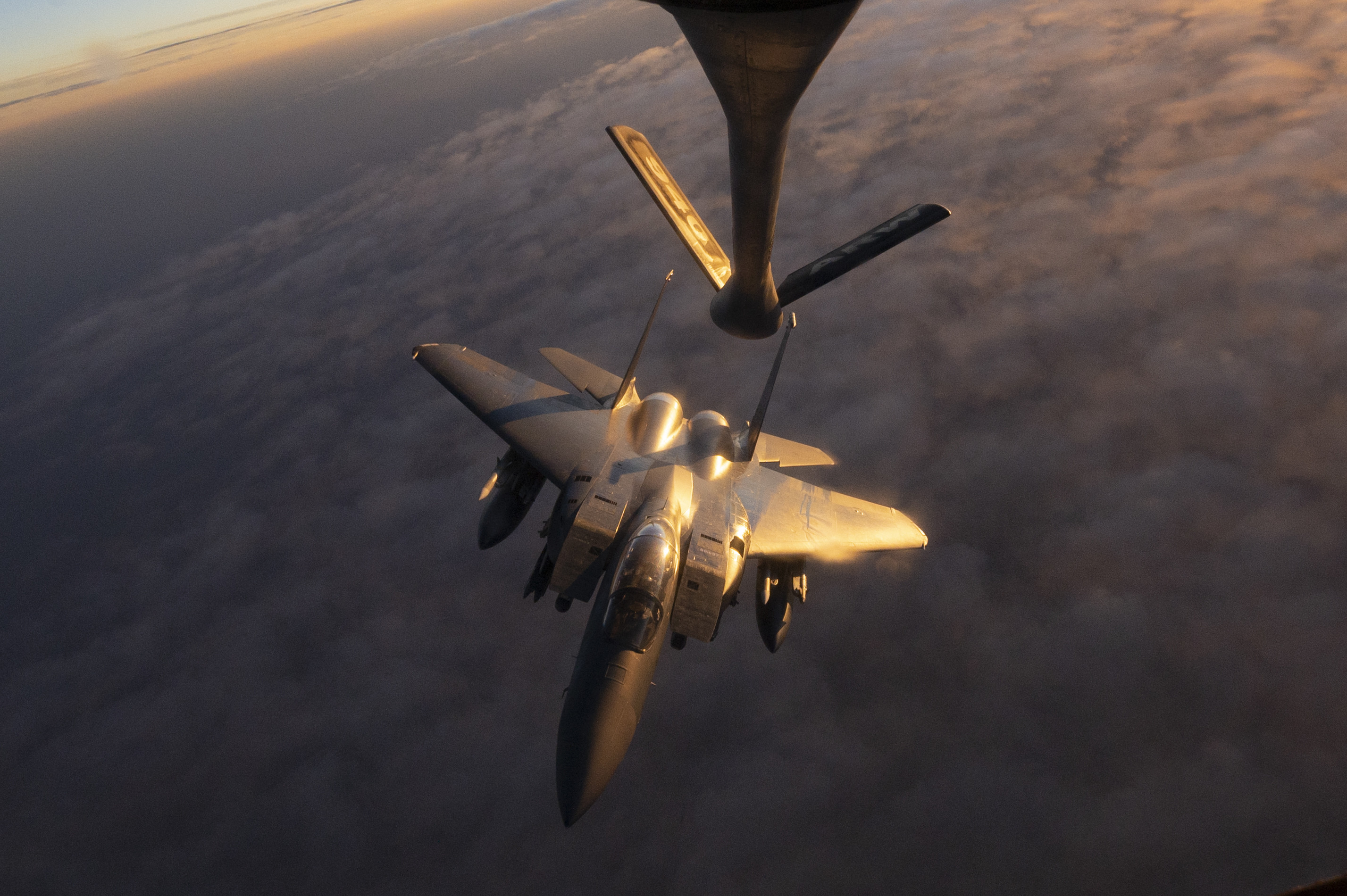Effective deterrence is not just about the number of fighter squadrons, the size of the naval fleet, or the number of stand-in forces.1Stand-in forces are small, lethal, low-signature mobile units designed to operate within a contested area and disrupt the plans of an adversary. It also depends on keeping those forces fed, providing ammunition for weapons, and fueling aircraft and ships to keep them in the fight. “The great problem of warfare in the Pacific is to move forces into contact and maintain them,” Gen. Douglas MacArthur, the commander of U.S. Army forces in the Pacific during World War II, observed, advising, “Victory is dependent upon the solution of the logistics problem.” MacArthur’s words are as apt today as they were 80 years ago.
Operating in the Indo-Pacific poses a different kind of challenge from deterring the Soviet Union on continental Europe during the Cold War, or more recently, fighting on battlefields across the Middle East and Afghanistan. Specifically, the United States confronts four “tyrannies” in the Indo-Pacific — distance, water, time, and scale — each of which complicates logistics and sustainment, and when combined, the four tyrannies interact to undermine deterrence. Pentagon planners need to understand this interactive effect and seek solutions that address the entire problem, not just each individual component.
Tyranny of Distance
The “tyranny of distance” has become something of a cliché, but it is no less true. The Department of Defense (DoD) has called a Taiwan contingency the “pacing scenario” and directed the services to optimize the U.S. force posture in the region for deterrence by denial. The physical separation between the United States and the Taiwan Strait adds to the deterrence challenge. Taiwan is located 100 miles off mainland China but nearly 6,000 miles from the continental United States — nearly twice the distance that stood between the United States and Europe during the Cold War. American military bases in the region are nearly as far away — the U.S. west coast is some 6,000 miles from Guam and over 5,000 miles from South Korea and the main islands of Japan. This distance works against U.S. deterrence, in part because it increases the logistical burdens, making a rapid and massive response less credible.
The economist Kenneth E. Boulding famously referred to this phenomenon as the “loss-of-strength gradient,” arguing that a state’s “military and political power diminishes as we move a unit distance away from its home base.” The longer the distance, and the longer the resulting supply chain, the larger the portion of the force that needs to be allocated to support (“tail”) roles rather than combat (“tooth”) roles. In other words, the long distance to the theater reduces the amount of combat power the United States can generate and sustain in the Indo-Pacific Theater.
Though Boulding later argued that technological changes — especially long-range aerial capabilities — were reducing this burden, the emergence of Anti-Access/Area Denial (A2/AD)2A2/AD concept is designed to limit access and deny freedom of movement to an adversary’s forces. threats has once again made forcible entry into a distant combat zone a difficult undertaking. Extended supply lines, cyberattacks on infrastructure, and strikes against disembarkation points would significantly complicate logistics and sustainment. In contrast to the logistical challenges facing U.S. forces, China’s closer proximity to the combat zone simplifies the logistical challenges of People’s Liberation Army (PLA), allowing China to rapidly concentrate a larger portion of military forces to combat operations than the United States. This geographical and logistical asymmetry between the United States and China favors Beijing to the detriment of U.S. deterrence.
Tyranny of Water
Once there, operating in the theater, U.S. forces must still contend with the vast stretches of ocean separating U.S. bases in the region. The U.S. Indo-Pacific Command encompasses about half the Earth’s surface, spanning both the Indian and Pacific Oceans. “You cannot appreciate how much water is out there until you’ve flown over it for five, 10, 12 hours in a row with no land in sight,” cautions Gen. Mike Minihan, the commander of the US Air Force Air Mobility Command. The vastness of these ocean areas concentrates and limits basing options while increasing the distances that U.S. aircraft and naval vessels must traverse to put their weapons within range of their targets. Many U.S. aircraft, especially short-legged fighter jets — with an average combat radius of 600 nautical miles (nm) — lack the necessary fuel to complete missions in the Taiwan Strait, for example, and return to existing U.S. bases in the region, including those in Japan.
Andersen Air Force Base (AFB) in Guam, for example, sits over 1,200 nm from the First Island Chain, but even Osan AFB in Korea is nearly 650 nm away. The United States has some access to bases located within the First Island Chain, such as Kadena and Yokota AFBs in Japan, but in the event of a conflict in the Taiwan Strait, these bases would push and, in some cases, exceed the combat radius of fifth-generation U.S. fighter jets. Meanwhile, common combat tactics — like traveling at supersonic speeds or planning routes around known and emerging threats — would further reduce the combat radius considerably. Put simply, many U.S. aircraft lack the range to bridge the stretches between U.S. bases in the region, while water landings and takeoffs are not viable for any fighters and most aircraft. The United States retired its last flying boats and seaplanes decades ago and has only recently begun to develop plans to build them again.
The problem is daunting. Aircraft carriers could be moved forward to close operational distances, but in a conflict they would be highly vulnerable to Chinese attacks from above and below the surface. Likewise, aircraft could be fueled in flight to extend their operational ranges, but refueling aircraft (or “tankers”) would make attractive targets for Chinese missiles. The current U.S. tanker fleet derives from commercial airframes — for example, the KC-46 is a variant of the 767 commercial jet airliner — and require relatively long runways, which attract Chinese missiles. Once airborne, these low-flying and slow-moving aircraft would be easy for China to detect and shoot down, resulting in the loss not only of the tanker, but also any fighter jets dependent on the onboard fuel. The United States might base tankers farther away from the conflict zone, but the aircraft would require more fuel to cover the distance, reducing what is available to offload to the receiving aircraft and significantly increasing the preplanning and time required to get them where they need to be. The tanker fleet is already hard-pressed to meet peacetime requirements, much less meet these wartime demands.
Having developed most of its tactical aircraft for conducting operations in Europe and the Middle East, where there are many fallback airfields and bases to compensate for short legs, the United States finds itself in danger of not being able to generate sufficient sorties to deny a quick and cheap victory for China. In pushing tankers back, the PLA could achieve air denial, and possibly even air superiority, without ever defeating U.S. air superiority fighters in combat. Given that achieving air superiority is critical to Beijing’s theory of victory, especially in a Taiwan scenario, the constraints of maritime geography, as well as Chinese missile threats, substantially weaken U.S. deterrence.
Tyranny of Time
For decades, successful extended deterrence has depended on America’s ability to rapidly project power into theaters across the globe. U.S. forward-postured forces, together with those of Washington’s allies and partners, could credibly threaten to deny a quick and cheap victory to any would-be adversary. The purpose of these forces has been to blunt attacks and thereby buy time for the United States to project massive combat power — hundreds of thousands of forces and their aircraft, ships, and vehicles — into the region.
But these forces and capabilities will not matter if they arrive too late to the fight. Distance is time. An aircraft carrier or fast-attack submarine needs about a week to sail across the Pacific. It takes 15-to-30 days to move troops, equipment, and supplies by sea from the U.S. West Coast to ports in Australia, Diego Garcia, Guam, or Japan. Long-range bombers and cargo aircraft can fly across the Pacific from the west coast in hours — nine hours from Hawaii to Japan or Korea and 14 hours from Alaska and Australia. But to create an air bridge — positioning aerial refueling tankers along the route — a minimum lead time of 24-to-48 hours is required.
Moreover, it would take months to deploy massive numbers of U.S. forces and weapons into the theater. The United States spent eight months building up to Desert Storm in 1990-1991. Before the 2003 invasion of Iraq, even with a continuous presence in the Middle East, it still took another six months to build up U.S. forces and the “iron mountain” of materiel required to support initial combat operations. This massive strategic lift operation also occurred under favorable conditions, given that Iraq lacked the military capabilities to contest or disrupt these movements. More fundamentally, time was on the United States’ side. The United States held the initiative, commencing military operations at the time and place of its own choosing. In the Indo-Pacific, China would most likely hold this advantage.
Today, the time disadvantage would remain a factor even once U.S. forces arrived in the theater. The U.S. Navy’s fleet of cruisers and destroyers need to return to a safe port or harbor to reload their missile canisters — the MK-41 Vertical Launch System — from supply ships. The missile transfer involves the use of cranes and therefore requires calm seas, meaning the ships would have to be at a safe distance from Chinese air and maritime threats. To reach those safe waters, ships would have to traverse stretches of the Pacific Ocean, but that added travel time would keep them out of the fight for days or weeks.
Time could also be lost to obtaining overflight rights and transit passage from neutral countries, or relying on alternative routes, which add time and distance. The United States has signed a series of agreements with Australia to step up a rotational military presence — including deployments of long-range bombers, submarines, and maritime patrol and reconnaissance aircraft — and establish an “enduring” logistics support area — designed to “accelerate the ability to respond to regional crises.” To operate from Australia, however, the United States would need to confront the region’s political geography.
The most direct route from Australia to the Taiwan Strait, for example, takes U.S. aircraft and ships through Indonesia’s airspace and archipelagic sea lanes, but Washington should not assume that permissions to traverse those areas will be forthcoming. Indonesia fiercely guards its sovereignty — accusing U.S. military aircraft of violations and sending fighter jets to intercept the aircraft and publicly threatening to close its waters to foreign submarines if they are involved in military operations. Without such permissions, however, Washington would face the unenviable choice of ignoring Indonesian restrictions or avoiding Indonesian airspace and waters altogether. Those detours would add hours of travel time, increasing requirements for aerial refueling or alternative access locations in Southeast Asia. Given the lack of reliable options for contingency basing in Southeast Asia, the United States might have to operate and sustain logistics over much longer exterior lines. The cost is in time. The longer it took for the United States to generate combat power, the more time China would have to seize its military objectives.
The credibility of U.S. deterrence depends on persuading China that it cannot achieve a rapid fait accompli. Beijing’s decision calculus could well turn on both how quickly it estimates U.S. reinforcements could arrive in the theater, specifically whether this window would be long enough for it to secure a military victory before the United States had sufficient combat power in the region, and how effectively a U.S.-led coalition could project combat power forward from bases located outside the First Island China. To deter China, then, the United States needs to demonstrate that it can both withstand and rapidly respond to military aggression with adequate mass. The ability to mobilize, deploy, and sustain the U.S. military is thus key to effective deterrence.
Tyranny of Scale
In the event of a conflict with China, U.S. logistics operations would be staggering in scale and complexity. Logistics and sustainment requirements are not linear — that is, there is not a one-to-one correspondence between additional “tooth” (combat forces) and “tail’ (support forces). Limited ramp space, for example, would require military planners to employ bombers and tankers from more operating bases, which would increase both aerial-refueling requirements and on-the-ground sustainment needs (e.g., maintenance and servicing, support facilities, and weapons storage sites, etc.). Additionally, the larger force package means more risk of some aircraft falling out of the mission, especially with an aging tanker fleet, which increases the number of spare tankers required to guard against a mission abort. In other words, if a mission involving one bomber requires six aerial refueling tankers, the same mission employing four bombers would then require more than 24 tankers.
More generally, large-scale combat operations create what RADM Henry Eccles colorfully called a “logistic snowball.” As he argued, “logistic activities tend to grow to inordinate size like a snowball . . .they tend to become rigid, and they tend to acquire a very physical momentum.”
The demands of modern warfare have increased the level of specialization in logistics — aircraft, warships, armored vehicles, munitions, and communication systems all require specialists to maintain them — expanding the size of the “tail” to sustain combat operations. This specialization extends to maintenance and sustainment within each service. In the Air Force, for example, there are six different maintenance specialties — engines, avionics, stealth components, fuel, egress, and weapons. Maintenance and ground crews need to bring specialized tools, ground equipment, test kits, and spare parts to keep runways smooth and aircraft flying.
On a recent peacetime mission, flying from Australia to the Philippines, a Marine Corps F-35C fighter squadron not only relied on the global spare parts pool and components from allied militaries but also traveled with “two 747s’ worth of spare parts and other cargo.” In wartime, the high tempo of operations over a prolonged period would exponentially increase maintenance demands over those in peacetime and could make the outsourcing of logistical support to private contractors less viable. This effect would extend to all weapons platforms and services, compounding the scale of the logistics and sustainment challenge.
The planning and execution of logistics and sustainment operations at scale is no easy task. In July 2023, the United States conducted Mobility Guardian 23, its largest multinational air mobility exercise held in the Indo-Pacific to date. The exercise involved 70 mobility aircraft and more than 3,000 personnel from the United States and six other allied countries — with operations in Hawaii, Guam, Australia, and Japan — practicing airlift, air refueling, aeromedical evacuation, air mobility ground-support operations, and command-and-control arrangements. Even with months of careful planning, the exercise encountered complications — for example, one C-17 aircraft from Travis AFB in California only made it to Hawaii because of mechanical issues with the jet, while others fell behind schedule due to weather; the slow arrival of jet-fuel trucks; and smaller gas tanks, requiring extra aerial refueling. These incidents are all manageable in isolation, but they compound one another to quickly have a cascading effect.
If an aircraft is delayed during take-off, for example, it continues to occupy ramp space, potentially preventing the landing of another inbound aircraft. During the Kabul Airlift, aircraft loaded with evacuees had to regularly circle above Al Udeid Air Force Base in Doha, Qatar, waiting for hours for space on the ground to open up before landing. With so many moving parts, logistics operations balance a set of interlocking puzzles — flight routes and tanker availability, open ramp space and timing, aircraft and ground maintenance crews, etc. Moving personnel and equipment is a carefully choreographed process. “That’s not as easy as it may sound,” Maj. Gen. Darren R. Cole, Air Mobility Command’s director of operations, strategic deterrence, and nuclear integration, acknowledged, “And it may look easy, but it’s just not. It takes a lot of practice.” Even then, the United States cannot ever practice at the tempo and scale required because such exercises are both expensive and increase the risks of misperception and escalation, meaning the U.S. military is unlikely to fully understand the problems created by the interaction of the four tyrannies short of war.
What the Prussian military theorist Carl von Clausewitz called “friction” — or those “factors that distinguish real war from war on paper” — complicate deterrence. Statistical estimates of sustainment rates are no substitute for the real thing. The danger is that Beijing is unlikely to ignore friction and assume away these issues in calculating how quickly the United States can project and sustain combat power in the region. Indeed, Chinese leaders might be counting on friction—and planning to make it a whole lot worse — to slow down a U.S. military response. Moreover, different U.S. and Chinese assumptions about friction could result in divergent expectations about the balance of military power. Uncertainty in military operations strengthens deterrence only when it casts doubt on Beijing’s military strategy and operational plans. Uncertainty has the opposite effect when it magnifies risks for the United States, reducing the credibility of U.S. deterrent threats.
Logistics Tradeoffs
To paraphrase MacArthur, deterrence is dependent upon the solution of the logistics problem. But that problem defies simple solution, complicated by the fact that solving one part of the problem often makes the others worse. In trying to address the tyranny of distance, for example, the United States could decide to deploy more forces forward. Without additional basing options, however, the forces would end up concentrated at large bases, leaving them vulnerable to an adversary’s first strike. To mitigate this threat, the United States could try to distribute its forces more widely within the first island chain, but a distributed force posture increases the complexity and scale of the logistics challenge. It also exacerbates the challenge of operating across large swaths of water. The United States could employ more ships and flying boats to remedy this situation, but this solution compounds the tyranny of scale.
Alternatively, the United States could opt to deploy its forces farther back from the conflict zone, but this option would increase time to the target, both giving the adversary more time to move into positions and increasing the scale and complexity of operations, including aerial-refueling requirements. The United States could try to employ more maritime logistics ships, but this option would increase the time it takes to resupply forces. There are no “silver bullets” to make the logistics and sustainment that underwrite U.S. deterrence in the Indo-Pacific any easier, faster, or more efficient and effective.
Strategy is often a series of tradeoffs, and U.S. deterrence strategy in the Indo-Pacific is no exception. The United States faces a set of logistics tradeoffs in deterring and, if necessary, defending against Beijing’s aggression in the region. Instead of trying to solve each part of the logistics problem, the Pentagon should develop an approach to cope with the four tyrannies and manage the tradeoffs among them. Doing so requires making hard choices to set priorities and accept risks that DoD would prefer to avoid. The challenge that confronts the U.S. military is to bring logistics and sustainment capabilities in line with U.S. strategic objectives. Doing so requires fully integrating logistics and sustainment into a theory of victory.
During the Cold War, the United States and its NATO allies chose to invest more heavily in logistics and combat support compared to the Soviet Union and other Warsaw Pact armies, with the United States allocating about 1.5 times as many personnel to command and support as the Pact to generate a given unit of firepower. Logistics were integral to NATO’s theory of victory — its superior logistics and support assets were “force multipliers” to offset the Warsaw Pact’s quantitative advantage over NATO. In other words, U.S. and NATO commanders recognized that superior logistics contributed more to deterrence and defense than simply building more tanks or aircraft. This lesson should not be lost on today’s defense planners.
All too often, however, logistics and sustainment are afterthoughts in U.S. defense strategy and doctrine. For example, the U.S. military services have all embraced some version of distributed combat operations — the U.S. Air Force’s Agile Combat Employment, the Navy and Marine Corps’ Distributed Maritime Operations, and the Army’s Multi-Domain Operations — but these concepts might not be feasible from a logistics and sustainment standpoint in practice. In 1914, Germany’s Schlieffen plan was arguably a sound and coherent campaign plan, at least on paper, but it proved logistically impracticable in the end because the railways supplying the German armies were not able to keep up with the pace of the German advance. The United States should not repeat the mistake of relegating logistics to a “backseat position” in strategy and doctrine.
Col. Maximilian K. Bremer, U.S. Air Force, is the director of the Special Programs Division at Air Mobility Command. The opinions expressed here are his own and do not reflect the views of the Department of Defense and/or the U.S. Air Force.
Kelly A. Grieco is a Senior Fellow with the Stimson Center’s Reimagining U.S. Grand Strategy Program.
Notes
- 1Stand-in forces are small, lethal, low-signature mobile units designed to operate within a contested area and disrupt the plans of an adversary.
- 2A2/AD concept is designed to limit access and deny freedom of movement to an adversary’s forces.




